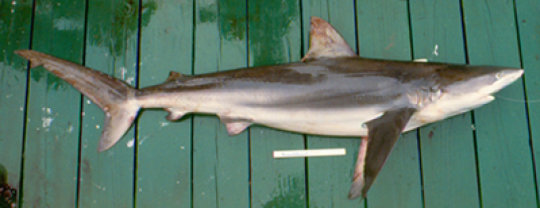[ad_1]
Band pairs in shark vertebrae have been used for decades to estimate shark age, of practical use in conserving overfished sharks and managing the remaining shark fisheries. However, recent research demonstrates that previous methods used to determine the age of sharks have underestimated those ages, particularly in older sharks.
The most widely used method counts growth band pairs laid down in individual vertebrae of the shark’s backbone. Band pairs appear as alternating opaque and translucent bands, similar in concept to those in tree growth rings. Determining the periodicity of the formation of these band pairs has been a challenge. None of the many studies conducted over the past 35 years had completely validated any shark species through an entire lifespan.
In the past, band pairs have most often been assumed to be annual. Some studies using chemical marking, such as Oxytetracycline (OTC), in combination with tag-recapture, and bomb radiocarbon dating have shown that this is often only true for a portion of the life of some species. Many of these studies have shown age underestimation in older sharks. This new study explored the relationship of band pair deposition to growth rather than time, explaining this discrepancy.
Researchers report that band pair deposition is closely linked to growth, specifically to the animal’s girth or body width. Band pair counts are related to vertebral size, rather than to time or age, and counts vary among vertebrae along the spinal column. As growth rate decreases with age, band pair deposition decreases, leading to age underestimation based on band pair counts.
The findings, reported in Marine and Freshwater Research, have implications for accurately assessing ages for fisheries management of these species.
“Vertebral bands serve an important structural and functional role in sharks,” said Lisa Natanson, a shark researcher in the Apex Predators Program at the Northeast Fisheries Science Center’s Narragansett Laboratory and lead author of the study. “We found that the band pairs increase relative to the growth in body length and girth over an individual animal’s lifespan.”
“What drives the band pair deposition remains unclear but it appears to be related to actions of the vertebral column, possibly based on body and swimming type of the species and the spring action required of the vertebral column for movement,” Natanson said. “This study suggests the alternating band pairs are related to structural aspects of the vertebra and are essential for physical support and flexibility of the individual animal rather than deposited in response to an external cue.”
Study co-author Marianne Porter of Florida Atlantic University is further studying the biomechanics of the vertebra of these species in relation to position along the vertebral column and band pair changes.
Small, medium and large specimens of seven shark species were examined and included shortfin mako, white, porbeagle, dusky, blue, common thresher, and Atlantic angel sharks. The goal of the study was to explore the potential relationship between band pair formation, vertebral structure and body shape, and not just age. Examining different species allowed differences in the band pair deposition rates, swimming style, body shapes, and maximum sizes to be considered.
Larger individuals were found to have more band pairs and more deviations in band pair number along the vertebral column. In general, the vertebral size and shape changes along the column in species-specific patterns: it increases from behind the head to the abdominal cavity or mid-section, then decreases to the tail region. The location of the vertebral size peak along the column differed among species.
“As sharks grow and gain muscle mass and girth, band counts start to deviate along the vertebral column,” Natanson said. “When growth in length slows or stops, growth in girth continues, particularly in the abdominal region, in many species. Smaller sharks had more consistent band pair counts along the column because their vertebrae were more similarly sized, whereas larger sharks had greater variation in band pair counts corresponding with more pronounced differences in girth from head to tail.”
One example of this variation was found in a porbeagle shark that was captured, measured, tagged and injected with OTC as a marker for age before release. The same shark was recaptured after 14.8 years during a fishing tournament attended by Natanson and study co-author Greg Skomal of the Massachusetts Division of Marine Fisheries. The known date of tagging, accurate length measurements, and the long time after release provided the opportunity to study band pair deposition from the OTC mark in all the vertebrae along the column. Band pair deposition past the OTC mark varied along the vertebral column, supporting the contention that band pairs are not deposited based on time.
Another method, using atomic bomb radiocarbon dating, has aided age validation in some shark species, but it has been consistent with only a portion of a shark’s lifespan, leading to underestimated ages in some species. If band pairs are not directly related to age, as this study suggests, the use of bomb radiocarbon techniques for age validation is called into question.
Specimens of various shark species were obtained from shark fishing tournaments, research cruises, and commercial fishermen in the western North Atlantic Ocean. Each specimen was measured for length — from the snout, over the body to the fork in the tail (known as fork length) — whole weight determined to the nearest kilogram, and sex and maturity stage identified. Samples were taken of both the whole vertebral column and as body cross-sections and measured the same way.
“This study has far-reaching implications for the conservation and management of shark species and the data needed to calculate productivity necessary for stock assessment modelling,” said Natanson. “Using improper ages can seriously alter the output of models, affecting management decisions. Future studies should perhaps assume that band pair deposition is not triggered by a time-related event, but rather by growth.”
[ad_2]















